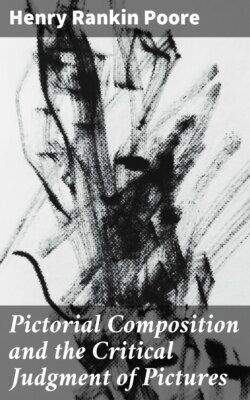Читать книгу Pictorial Composition and the Critical Judgment of Pictures - Henry Rankin Poore - Страница 7
На сайте Литреса книга снята с продажи.
CHAPTER III - BALANCE
ОглавлениеTable of Contents
Of all pictorial principles none compares in importance with Unity or Balance.
“Why all this intense striving, this struggle to a finish,” said George Inness, as, at the end of a long day, he flung himself exhausted upon his lounge, “but an effort to obtain unity, unity.”
The observer of an artist at work will notice that he usually stands at his easel and views his picture at varied distances, that he looks at it over his shoulder, that he reverses it in a mirror, that he turns it upside down at times, that he develops it with dots or spots of color here and there, points of accent carefully placed and oft-times changed.
What is the meaning of this thoughtful weighing of parts in the slowly-growing mosaic, but that he labors under the restraint of a law which he feels compelled to obey and the breaking of which would cause anguish to his esthetic sense. The law under which his striving proceeds is the fundamental one of balance, and the critical artist obeys it whether he be the maker of vignettes for a newspaper, or the painter who declares for color only, or the man who tries hard to produce naivete by discarding composition. The test to which the sensitive eye [pg 26] subjects every picture from whatsoever creed or camp it comes is balance or equipoise, judgment being rendered without thought of the law. After the picture has been left as finished, why does an artist often feel impelled to create an accent on this side or weaken an obtrusive one on the other side of his canvas if not working under a law of balance?
Let any picture be taken which has lived long enough before the public to be considered good by every one; or take a dozen or more such and add others by artists who declare against composition and yet have produced good pictures; subject all these to the following simple test: Find the actual centre of the picture and pass a vertical and horizontal line through it. The vertical division is the more important, as the natural balance is on the lateral sides of a central support. It will be found that the actual centre of the canvas is also the actual pivot or centre of the picture, and around such a point the various components group themselves, pulling and hauling and warring in their claim for attention, the satisfactory picture showing as much design of balance on one side of the centre as the other, and the picture complete in balance displaying this equipoise above and below the horizontal line.
Now, in order that what seems at first glance an exclusive statement may be understood, the reader should realize that every item of a picture has a certain positive power, as though each object were a magnet of given potency. Each has attraction for the eye, therefore each, [pg 27] while obtaining attention for itself, establishes proportional detraction for every other part. On the principle of the steelyard, the farther from the centre and more isolated an object is, the greater its weight or attraction. Therefore, in the balance of a picture it will be found that a very important object placed but a short distance from the centre may be balanced by a very small object on the other side of the centre and further removed from it. The whole of the pictorial interest may be on one side of a picture and the other side be practically useless as far as picturesqueness or story-telling opportunity is concerned, but which finds its reason for existing in the balance, and that alone.
In the emptiness of the opposing half such a picture, when completely in balance, will have some bit of detail or accent which the eye in its circular, symmetrical inspection will catch, unconsciously, and weave into its calculation of balance; or if not an object or accent or line of attraction, then some technical quality, or spiritual quality, such, for example, as a strong feeling of gloom, or depth for penetration, light or dark, a place in fact, for the eye to dwell upon as an important part in connection with the subject proper, and recognized as such.
But, the querist demands, if all the subject is on one side of the centre and the other side depends for its existence on a balancing space or accent only, why not cut it off? Do so. Then you will have the entire subject in one-half the space to be sure, but its harmony or balance will [pg 28] depend on the equipoise when pivoted in the new centre.
